The use of super glue on fabric – a versatile solution for quick fixes and minor repairs.
Super glue, also known as cyanoacrylate adhesive, is renowned for its rapid bonding capabilities, making it a convenient choice for mending torn seams, reattaching loose hems, or fixing small tears in the fabric.
In this discussion, we explore the compatibility of superglue with various fabric types, recommended safety precautions, and the advantages it offers.
Understanding the right techniques and adhesive types can empower you to make effective, lasting fabric repairs. Join us on this journey to discover the possibilities and limitations of using superglue on fabric.
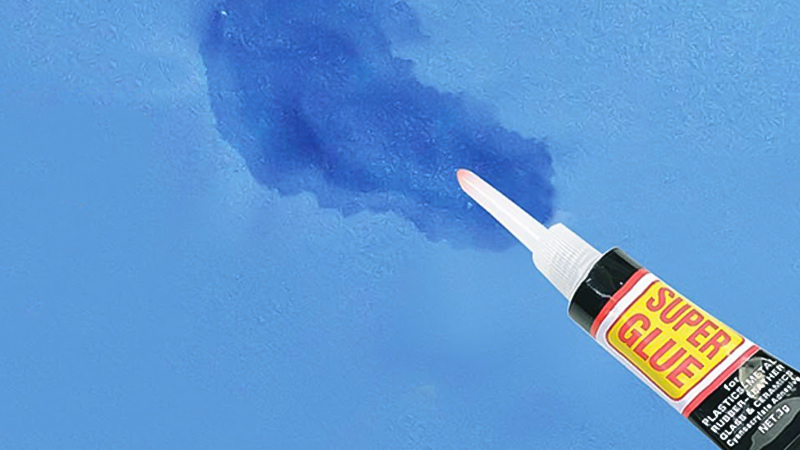
What Is Super Glue?
Super glue, scientifically known as cyanoacrylate adhesive, is a fast-bonding and powerful adhesive renowned for its versatility and strength.
It belongs to a family of strong, quick-drying adhesives that form a near-instantaneous bond when in contact with certain surfaces, primarily through a chemical reaction with moisture.
This transparent, resin-like substance is valued for its ability to adhere to a wide range of materials, including plastics, metals, ceramics, and even some fabrics.
Super glue finds extensive use in various applications, from household repairs to industrial settings, making it a staple adhesive for swiftly and securely joining different materials together.
Can You Use Super Glue on Fabric?
Yes, you can use super glue on fabric, but it’s important to do so with caution and under specific circumstances.
Superglue, also known as cyanoacrylate adhesive, is a powerful and fast-bonding adhesive that can be used on various materials, including fabric
Here are some guidelines and tips for using super glue on fabric:
Fabric Type
When choosing to use super glue on fabric, consider the type of fabric you’re working with. For instance, lightweight and delicate fabrics like silk or chiffon can be challenging due to their thin nature.
The glue may seep through or create a visible spot. On the other hand, thicker fabrics such as denim or canvas tend to provide a better surface for the adhesive to bond.
Clean the Fabric
Ensure that the fabric is spotless from any dirt, oils, or residue.
This can be achieved by gently wiping the area with a clean, dry cloth or using a mild fabric cleaner if necessary. A clean surface provides a better foundation for the adhesive to adhere.
Test a Small Area
Before committing to a full application, it’s prudent to perform a test on a discreet part of the fabric.
Apply a small amount of super glue and observe how it interacts with the material. This precautionary measure can reveal any potential issues like discoloration or unwanted stiffness.
Apply Sparingly
Less is more when it comes to superglue Apply a thin, even layer of adhesive to the edges or surfaces you intend to join.
Excessive application can lead to seepage and unsightly residue. Precision is key to achieving a seamless bond.
Work Quickly
Super glue’s rapid drying time necessitates a swift and decisive approach. Once the adhesive is applied, promptly align the edges or pieces and press them together firmly. Maintaining pressure for a few seconds ensures a secure bond.
Ventilation
It’s crucial to work in a well-ventilated area when using super glue. The fumes emitted by the adhesive can be potent and may cause irritation. Adequate airflow helps dissipate these fumes and reduces the risk of inhaling them.
Avoid Using Stretchy or Elastic Fabrics
Elastic or stretchy fabrics, like spandex or elastic blends, pose a challenge for superglue.
The adhesive may not adhere well to these materials, and it can impede the fabric’s natural elasticity. In such cases, alternative methods such as fabric glue or sewing may be more effective.
Wash Carefully
When you need to wash fabric repaired with super glue, exercise caution. Follow the care instructions provided for the fabric, and opt for gentle washing methods.
It’s worth noting that frequent washing may gradually weaken the bond over time, so handle the fabric with care
Various Types of Fabric Suitable for Super Glue
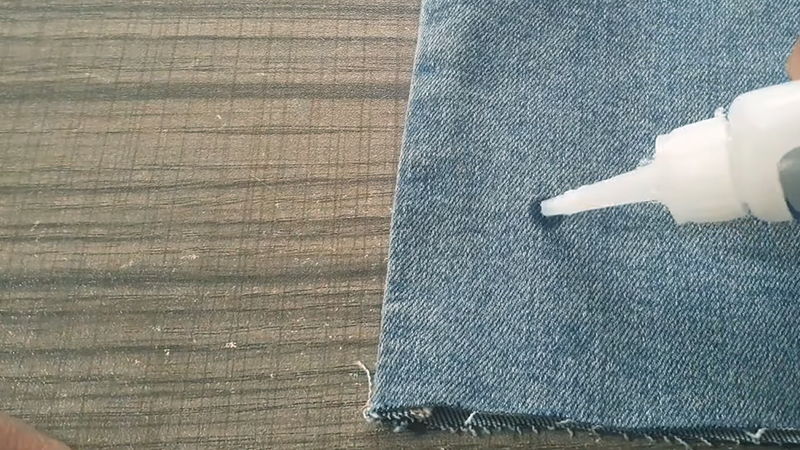
Super glue can work well with various types of fabric, especially when used for quick fixes or minor repairs.
Here are some types of fabric that are generally suitable for bonding with super glue:
Cotton
Cotton is a versatile and widely used natural fiber known for its breathability and comfort. It’s commonly found in clothing, linens, and various household items.
Super glue can effectively bond cotton fabric, making it an excellent choice for quick fixes like repairing torn pockets, and loose seams, or attaching small embellishments.
Denim
Denim is a sturdy, twill-woven fabric typically made of cotton. It’s renowned for its durability and is often used in jeans, jackets, and other rugged apparel.
Super glue can be highly effective for mending denim, especially for patching up holes or reattaching loose belt loops.
Canvas
Canvas is a heavy, plain-woven fabric often made from cotton or a blend of fibers. It’s widely used for items like tote bags, sails, and outdoor equipment.
Super glue provides a strong bond on canvas, making it useful for quickly repairing torn seams or small holes.
Polyester
Polyester is a synthetic fabric known for its durability, wrinkle resistance, and moisture-wicking properties.
It’s commonly used in sportswear, outerwear, and various textiles. Super glue can be employed to fix minor tears or reinforce seams in polyester garments.
Nylon
Nylon is a synthetic fabric celebrated for its strength, abrasion resistance, and water-repellent qualities. It’s found in a wide range of applications, from backpacks and luggage to parachutes and sportswear.
Super glue is well-suited for repairing nylon items, especially for reattaching straps or mending small punctures.
Felt
Felt is a non-woven fabric made from compressed fibers, often wool or synthetic materials. It’s commonly used in crafts, as well as for making hats, slippers, and other soft items.
Super glue can be used to securely attach pieces of felt together, making it useful for crafting projects or quick repairs.
Linen
Linen is a natural fabric made from flax fibers known for its breathability and moisture-wicking properties.
It’s often used in summer clothing and household textiles. While linen can be delicate, super glue can be employed for minor repairs like reattaching small embellishments or fixing loose hems.
Velvet
Velvet is a luxurious, plush fabric known for its softness and distinctive texture. It’s commonly used in formal wear, upholstery, and home decor.
While using super glue on velvet may not be the first choice, it can be employed for discreet repairs, such as reattaching small embellishments or fixing minor tears.
Flannel
Flannel is a soft, woven fabric known for its warmth and comfort. It’s often used in shirts, pajamas, and bedding. Super glue can be used to repair flannel garments, especially for reattaching loose hems or seams.
Upholstery Fabric
Upholstery fabric is typically a heavy, durable material used to cover furniture. It can be made from a variety of fibers, including cotton, polyester, and blends.
Super glue can be useful for quick repairs on upholstery fabric, such as fixing loose seams or attaching small patches.
How Do Use Super Glue on Fabric?
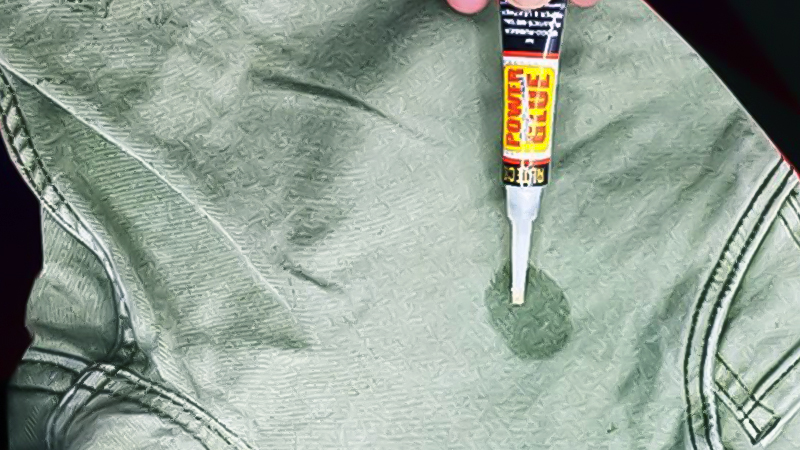
Using super glue on fabric requires careful handling to ensure a strong bond without damaging the material.
Here are the steps you should follow:
Gather Materials:
- Super glue (cyanoacrylate adhesive)
- Clean cloth for wiping any excess glue
- Fabric that needs to be repaired
Clean the Fabric
Spotless the fabric around the area where you intend to apply the super glue. Use a clean, dry cloth to remove any dirt, dust, or oils. A clean surface ensures better adhesion.
Test in an Inconspicuous Area
Before applying super glue to the visible part of the fabric, perform a small test in an inconspicuous area to check for compatibility and any potential adverse reactions.
Prepare the Super Glue
Carefully read and follow the manufacturer’s instructions on the super glue packaging. Open the glue and have it ready for application.
Apply Super Glue Sparingly
Apply a minimal amount of super glue to one of the fabric pieces. For small repairs, a drop or two is usually sufficient. Ensure that you’re not over-applying the glue, which could lead to seepage or visible residue.
Press and Hold
Quickly align the edges or the parts you want to join. Press them together firmly. Holding the pieces in place for a few seconds allows the glue to set.
Some super glues bond within seconds, while others may take a minute or two. Refer to the product instructions for precise drying times.
Reinforce the Bond
When the fabric pieces are large or if you want extra security, consider reinforcing the bond by sewing over the glued area once the glue has dried. This added stitching provides additional strength.
Allow Drying Time
Let the super glue dry completely. The drying time can vary depending on the glue type and the amount used. For optimal results, allow for the recommended drying time specified on the glue packaging.
Inspect and Trim Excess
After the glue has dried, carefully inspect the repaired area. Ensure that the bond is strong and secure. If there is any excess glue visible, you can gently trim it away with scissors.
Wash and Care
When necessary, wash the fabric according to the care instructions. Keep in mind that frequent washing may weaken the bond over time. Follow the fabric’s recommended care guidelines to maintain the repair.
Store the Glue Properly
Seal the superglue container tightly to prevent it from drying out and becoming less effective. Store it in a cool, dry place, away from direct sunlight and heat sources.
Advantages of Using Super Glue on Fabric
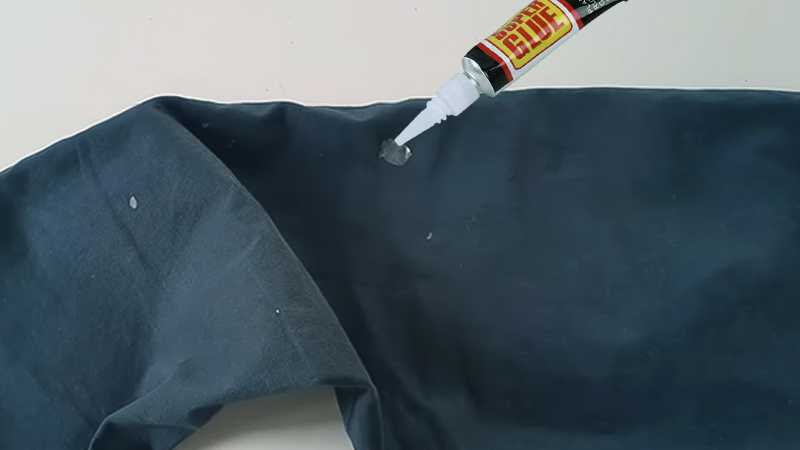
Using super glue on fabric offers several advantages, making it a convenient option for certain types of fabric repairs.
Here are some of the key advantages:
Quick and Efficient Repairs
Super glue dries rapidly, often within minutes, allowing for swift and efficient fabric repairs. This is particularly useful for situations where immediate attention is required.
Strong and Durable Bond
When applied correctly, superglue creates a robust bond that can withstand regular wear and tear. It provides a long-lasting solution for fabric items that may be subject to stress or strain.
Versatility
Super glue is compatible with a wide range of fabric types, including cotton, denim, canvas, polyester, and more. This versatility makes it suitable for various clothing items, accessories, and household textiles.
Minimal Equipment Required
Using super glue for fabric repairs doesn’t necessitate specialized tools or equipment. All that’s needed is the glue itself and a clean surface.
Clean and Invisible Bond
When applied correctly, super glue forms a nearly invisible bond, leaving no unsightly residue or visible stitching.
This is especially advantageous for repairs on delicate fabrics or in situations where aesthetics are important.
Convenience and Accessibility
Superglue is readily available in most hardware stores, pharmacies, and supermarkets. It’s a common household item, making it easy to obtain in case of emergencies or impromptu repairs.
Low Cost
Super glue is an affordable solution for fabric repairs. A small amount of glue can go a long way, making it a cost-effective option for minor fixes.
Ease of Application
Applying super glue is a straightforward process that requires no special skills or training. With a bit of care and attention, even beginners can achieve effective results.
Applicable to various Fabric Issues
Super glue can be used to address a range of fabric-related problems, including loose seams, small tears, detached embellishments, and more. It provides a versatile solution for a wide array of fabric repair needs.
Reduced Need for Sewing
For individuals who may not have sewing skills or access to a sewing kit, super glue offers a viable alternative. It allows for repairs without the need for a needle and thread.
Which Kinds of Super Glue Is Suitable for Fabric?
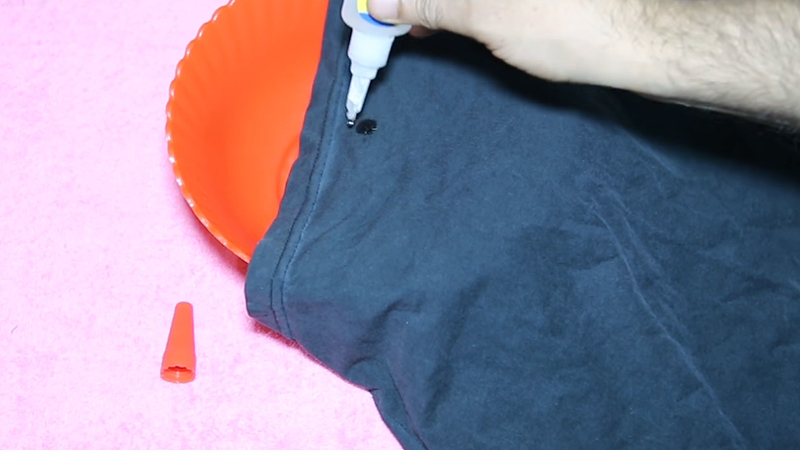
When choosing a super glue for fabric, it’s important to select one that is specifically designed for this purpose.
Look for super glues that are labeled as fabric-friendly or suitable for use on textiles. Additionally, it’s recommended to opt for a clear-drying formula to ensure a discreet and seamless bond.
Here are some types of superglue that are generally considered suitable for fabric:
Fabric-Specific Super Glue
Certain brands produce superglues explicitly designed for fabric applications. These formulations are crafted to provide a strong bond without causing damage or discoloration to the fabric.
Fabric and Leather Bonding Adhesives
Some super glues are marketed as suitable for both fabric and leather. These formulations are crafted to work well with a variety of textiles, providing a versatile option for fabric repairs.
Flexible or Flexible Setting Super Glues
Some super glues are labeled as flexible or are designed to have a flexible setting once cured. These types can be more forgiving on fabrics that may experience some movement or stretching.
Gel Super Glue
Gel formulations tend to be more viscous and have a thicker consistency compared to liquid superglues. This can make them easier to control and less likely to seep through thin or porous fabrics.
No-Run or No-Drip Formulas
No-run or no-drip superglues are engineered to stay in place once applied, which can be particularly beneficial when working with vertical surfaces or fabrics with a slight incline.
Multi-Surface Super Glue
Some multi-surface superglues are designed to bond various materials, including fabric. However, it’s important to verify that the specific product is suitable for fabric applications.
Acrylic-Based Fabric Adhesive
Some fabric-specific adhesives are acrylic-based, providing a strong and flexible bond on textiles. These adhesives are designed to withstand washing and laundering.
Potential Challenges and Solutions
When using super glue on fabric, there are some potential challenges you may encounter.
Here are a few common issues and their corresponding solutions:
Discoloration or Stiffness
- Challenge: Super glue can sometimes leave a white residue or make the fabric feel stiff.
- Solution: Test the glue on an inconspicuous area first. Use a minimal amount of glue, and consider using a fabric-specific formula designed to prevent discoloration or stiffness.
Seepage Through Thin Fabrics
- Challenge: Thin fabrics like silk or chiffon may allow the glue to seep through, creating a visible spot on the other side.
- Solution: Apply the glue sparingly, and work on a clean, flat surface. Place a barrier, like wax paper, underneath to prevent seepage.
Difficulty with Stretchy Fabrics
- Challenge: Stretchy or elastic fabrics can be challenging to bond with superglue, as they tend to move and stretch.
- Solution: Consider using fabric glue or a needle and thread for stretchy fabrics. If using super glue, stretch the fabric slightly during application and hold it in place until the glue sets.
Sensitive Fabrics
- Challenge: Delicate fabrics may be more prone to damage or discoloration when exposed to superglue.
- Solution: Test a small, inconspicuous area first. Opt for a fabric-friendly super glue or consider using fabric glue for delicate materials.
Ventilation and Fumes
- Challenge: Super glue emits fumes that can be strong and irritating, requiring adequate ventilation.
- Solution: Work in a well-ventilated area or use a fan to help dissipate fumes. Consider wearing a mask or working near an open window.
Not Suitable for All Fabric Types
- Challenge: Super glue may not be the best option for all fabrics, particularly those with special coatings or finishes.
- Solution: Test a small area first and consider alternative options like fabric glue or sewing for fabrics that may not bond well with super glue.
Durability Over Time
- Challenge: Frequent washing or exposure to moisture can weaken the bond of superglue over time.
- Solution: Follow the care instructions for the fabric, and consider reinforcing the bond with additional stitching if necessary.
Difficulties in Applying Small Amounts
- Challenge: It can be challenging to apply superglue in small, precise amounts.
- Solution: Use a fine-tipped applicator or apply a small amount to a disposable surface and use a toothpick or cotton swab to transfer the glue to the fabric.
Safety Measures When Working With Super Glue
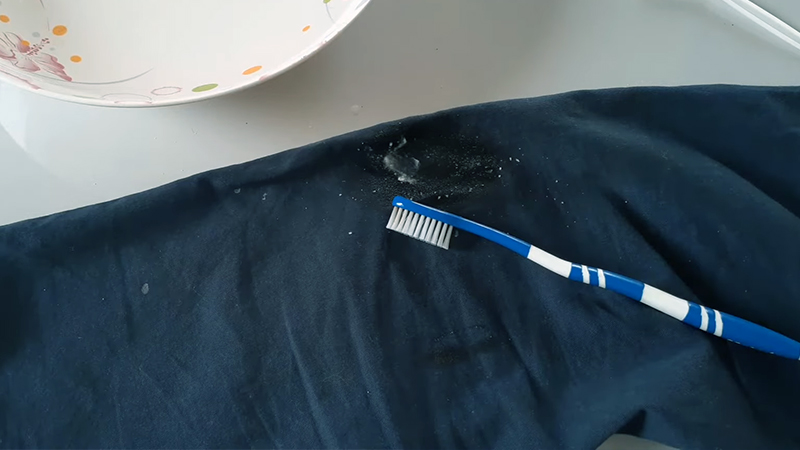
When working with superglue, it’s crucial to observe certain safety measures to ensure a safe and successful application.
Here are some important precautions and steps to keep in mind:
Ventilation
Work in a well-ventilated area. Super glue fumes can be strong and may cause irritation if inhaled for extended periods. Opening windows or using a fan can help disperse the fumes.
Eye Protection
Wear safety goggles or glasses to protect your eyes from accidental splashes or spills. Super glue can cause irritation or damage if it comes into contact with your eyes.
Skin Protection
Consider wearing disposable gloves, especially if you’ll be handling a significant amount of superglue. This can help prevent accidental skin contact, which can lead to irritation or bonding of skin.
Avoid Contact with Clothing
Be cautious not to get super glue on your clothing. It can bond fabric together, potentially causing damage to the garment.
Avoid Contact with Mouth and Nose
Do not chew on objects or breathe in the fumes when working with superglue. Ingesting or inhaling superglue can be harmful.
Use in a Controlled Manner
Apply super glue carefully and precisely. Use small amounts and avoid applying too much adhesive, which can lead to seepage or excess glue on the fabric.
Store Properly
Keep super glue containers tightly closed and stored in a cool, dry place, away from heat sources or open flames. This helps prevent accidents and prolongs the shelf life of the glue.
Clean Up Spills Immediately
When you accidentally spill super glue, clean it up promptly. Acetone or nail polish remover can be effective in removing super glue from surfaces, but be sure to test in an inconspicuous area first to ensure it won’t damage the material.
Keep Unreachable Children and Pets
Store super glue in a location where it’s inaccessible to children or pets. It’s a strong adhesive and should be used with care.
Emergency Preparedness
Have a plan in case of accidental contact with super glue. Knowing how to handle situations like skin bonding or eye exposure can be crucial for quick and effective treatment.
FAQs
Can you use super glue on all types of fabric?
No, super glue is best suited for certain fabrics like cotton, denim, and canvas.
How do I test if superglue is safe for a specific fabric?
Perform a small, inconspicuous area test. Apply a tiny amount of super glue and check for any adverse reactions such as discoloration or damage to the fabric.
Is super glue machine washable when used on fabric?
Super glue can withstand mild machine washing often, but frequent washing may weaken the bond over time. Follow the fabric care instructions for handwashing for longevity.
Can I use super glue to mend large tears in the fabric?
Super glue is best for small repairs and bonding edges together. For substantial tears or more extensive fabric damage, sewing or fabric glue may be more effective.
What safety precautions should I take when using super glue on fabric?
Safety measures are good ventilation, wearing protective eyewear and gloves, and avoiding contact with skin, eyes, and clothing.
Wrap Up
Using super glue on fabric can be an effective solution for quick and durable repairs. Selecting the right type of super glue, testing it on a small area, and working in a well-ventilated space are essential steps.
While super glue offers convenience, it’s crucial to handle it with care to ensure a successful outcome. However, for larger tears or delicate fabrics, alternative methods like sewing or fabric glue may be more appropriate.
By following safety precautions and using super glue judiciously, it’s possible to mend fabrics efficiently, extending the lifespan of cherished garments and textiles. Always remember to prioritize safety and precision when working with this adhesive.
Leave a Reply